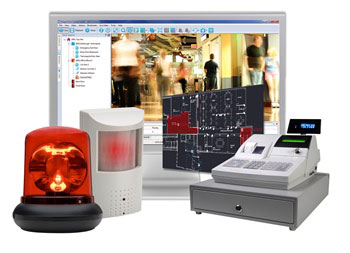
Make the seconds count with IndigoVision’s DNA
“You can’t ensure people’s safety if you lose access to live video.”
It seems an obvious statement for those working in the security industry, right?
So why do many organizations still lose valuable seconds when system faults leave them unable to view live video in critical incidents?
People’s lives can change dramatically in seconds, so IndigoVision’s DNA is built to make those seconds count. In critical infrastructure - assets that are essential for a society and economy to function, such as hospitals, prisons and transport networks - security teams rely on DNA because there can never be a situation where they lose access to live video.
IndigoVision’s unique Distributed Network Architecture (DNA) enables camera footage to be transmitted directly to your Control Room rather than through a central server, which means that a fault somewhere in your system won’t affect your ability to view live camera footage. Additionally, by bypassing the server, you are able to view images from your cameras without any lag time.
DNA therefore helps security teams across a huge range of industries to respond better and faster to incidents.
Save Lives
In hospitals, it is critical that surveillance systems are constantly recording so that the security team can intervene as soon as possible, or even prevent incidents from happening at all. In a split second, violence could escalate in a hospital waiting room or an intruder could try to break into a secure facility.
The hospital’s surveillance system must provide operators with the right information at the right time, to ensure they can respond effectively in order to avoid critical incidents.
Consider a worst-case scenario for a hospital site: a fire has broken out and started to spread, destroying the Network Video Recorder (NVR) which records footage in that part of the building. In many security systems, this would mean that the security team loses complete visibility of the fire because they are unable to view footage from any camera attached to this NVR. As a result, the security team would be unable to support the emergency response to the fire or protect the lives of staff and patients in the hospital.
However, the hospital is using a surveillance solution from IndigoVision and the unique system architecture (i.e. DNA) enables the security team to maintain constant visibility of the fire as it spreads. With DNA, cameras transmit video directly to the Video Management System (VMS) as well as via the NVR. Even though the NVR is destroyed and is no longer recording, operators in the control room can still view live video when it matters the most.
Consequently, the security team provides emergency responders with accurate and timely information regarding the fire’s location. In addition, they communicate where the nearest patients are located, enabling staff to conduct a safe evacuation where necessary.
The hospital’s security team is therefore a direct reason why the fire department can control the blaze more quickly, saving lives in the process. At no point during the incident do the security operators on duty lose control of the situation, even though they are dealing with a stressful event.
Secure Arrests
Prisons require security systems that can accurately track and report incidents that unfold within and outside the main facility, to maintain visibility of inmates and for investigations. Some prison systems are monitored by one main control room off-site which gets footage from a number of different facilities, in order to consolidate operations and improve efficiency.
Many of the manned watchtowers which you would expect to see on the perimeter of prisons have now been replaced by modern Pan-Tilt-Zoom (PTZ) cameras, which are controlled remotely by an operator from a control room. This new method provides several advantages for prison security teams. One operator can monitor several cameras at the same time so they can oversee a much greater area and analytics software in PTZ cameras, such as motion detection and thermal screening, can help operators to spot inmates trying to escape much sooner than they could manually, even if it is dark.
With some types of surveillance systems, operators often experience delays when they try to remotely control a PTZ camera from the control room, because the instruction has to travel through the server and then to the camera. This can mean operators lose sight of suspects on camera.
With Distributed Network Architecture (DNA), camera images aren’t going through the server and can instead pass directly from the camera to the VMS, which makes PTZ cameras much more responsive to control in real time. Operators can therefore keep their eyes on a fleeing suspect and track them with pin-point accuracy, providing detailed location information to security guards on the ground. This makes it much more likely that the suspect will be re-arrested and returned to the prison, rather than escape.
Ensure Accurate Intelligence
Transit environments are often crowded spaces, which makes it challenging for security operators to identify specific people who might be about to commit a crime. It isn’t easy to differentiate between someone who is loitering versus someone who has simply arrived at the station 20 minutes before their departure.
You’ll often find that there are lots of cameras installed around stations, for the purpose of eliminating blind spots where crimes could occur. The first benefit of DNA is that even if one of your cameras has stopped working, this won’t affect the rest of your system. That gives your team the time to replace the camera and if necessary cordon off the affected area, without worrying about incidents that might be occurring all over your station because one camera failure has resulted in a much larger outage.
Additionally, DNA provides your security team with accurate intelligence that can be passed onto police, helping them to resolve incidents and secure convictions. Once again, this comes down to the fact that IndigoVision’s DNA does not require camera images to pass through a central server before it transmits to your VMS. For example, a suspect may have been flagged by facial recognition analytics because they returned to the same spot in the station several times over the course of one hour. A security guard goes to investigate the area and discovers that a window had been broken and walls are vandalised with graffiti.
DNA ensures the security team receives camera footage and precise times that the suspect was identified entering and leaving the area. The footage is dual-watermarked to prove that it has not been tampered with, so police can use the footage in a court of law to isolate exact times that the suspect was in the area and use this accurate intelligence to secure a criminal conviction.
IndigoVision’s DNA provides a higher level of protection during critical incidents, so that you can be confident that your security team always has access to live video and accurate information to resolve crimes and ensure people’s safety. DNA saves valuable time for your security team, when seconds can mean the difference between the avoidance or escalation of a major incident.








